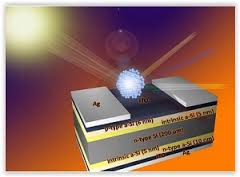1) US researchers develop world’s smallest transistor ever.
- US Department of Energy’s Lawrence Berkeley National Laboratory have created the world’s smallest (one-nanometre gate) transistor lead by researcher Ali Javey.
- Green energy to power all lighthouses by December.
- All lighthouses dotting India’s 7,517 km coast line will be fuelled by solar energy by December which would help reduce emission of 6,000 kg of greenhouse gases per day.
2) New termite species spotted in Malabar Wildlife Sanctuary.

- A new termite species, Glyptotermes Chiraharitae, has been discovered at Kakkayam in the Malabar Wildlife Sanctuary (Kerala) The species are named Chiraharitae.
- SC stays commercial release of GM mustard.
- The Supreme Court stayed the commercial release of Genetically Modified (GM) Mustard crop for 10 days and asked the Centre to take public opinion on such seeds before releasing them for cultivation.
3) Indian researcher produces stable solar cells.

- In a first, a researcher Abhishek Swarnkar from Pune’s Indian Institute of Science Education and Research (IISER) has successfully produced a stable, high-efficiency, all-inorganic perovskite nanocrystal solar cells.
- The new material has 10.77% efficiency to convert sunlight to electricity.
4) Demystifying Science: Great Balls of Fire.
- The Great Balls of Fire (GBF) are mysterious, super-hot blobs of gas which were detected by the Hubble Space Telescope.
- The Great Balls of Fire (GBF) have continued once every 8.5 years for at least the past 400 years.
5) High-altitude glacial lab opens in the Himalayas.

- The glaciological research lab inaugurated by M. Rajeevan, Secretary to the Ministry of Earth Sciences at Himansh in the Spiti Valley on October 10, 2016. It was located at an altitude of nearly 13,500 feet.
- Spiti Valley, one of the most uninhabited parts of the country, Himansh is considered to be the highest point from where an Indian glacier research facility is functioning.
- The research lab, established by the National Centre for Antarctic and Ocean Research (NCAOR), has automatic weather stations, ground penetrating radars, geodetic GPS systems and other sophisticated facilities to study glaciers and their discharge.
- M. Rajeevan, Secretary to the Ministry of Earth Sciences, inaugurated the facility. M. Ravichandran, director NCAOR, was also present.
6) New species of Jurassic reptiles discovered.

- Scientists have identified a new species of extinct marine reptiles, that lived during the age of the dinosaurs, from fossils collected over a century ago.
- The newly identified species of British Ichthyosaur, which resembled dolphins or sharks, were ocean dwelling reptiles. They were fierce predators, some growing up to 15 metres long.
- Ichthyosaur lived around 200 million years ago in the early Jurassic period, a time when the U.K. was a small series of islands.
- The six year study, led by the University of Manchester, set out to search for British examples of Ichthyosaurs. The new species has been identified was on display at the University of Bristol.
7) NASA develops electroactive bandages to speed up wound healing.

- NASA has developed a new high-tech material that uses electricity to significantly promote healing of injured wounds.
- The new material generates a small amount of electricity when interacting with another surface, including human skin.
- The material, called polyvinylidene fluoride (PVDF), has numerous possible applications, including wound healing.
- If the PVDF fibres are aligned correctly, cells on a wound use it as a scaffold, helping the wound to heal faster.